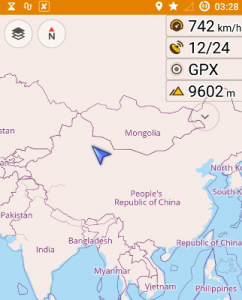 Good techno-thrillers with realistic plots and technical details are hard to come by and it seems they are mainly coming from what I would call “alternative authors” these days. Case in point are Chronos by William Hern, The Martian by Andy Weir and books by Mark Russinovich like Rouge Code that I’ve reviewed and recommended in the past. Here’s another one “The One Billion Dollar Heist” by Ben Lovejoy!
Good techno-thrillers with realistic plots and technical details are hard to come by and it seems they are mainly coming from what I would call “alternative authors” these days. Case in point are Chronos by William Hern, The Martian by Andy Weir and books by Mark Russinovich like Rouge Code that I’ve reviewed and recommended in the past. Here’s another one “The One Billion Dollar Heist” by Ben Lovejoy!
A Busch 2090 Emulator on an Arduino
Over the past years I’ve explored many ways how to combine my memories of computing of the 1980’s with my quest to better understand how a CPU works and using contemporary technology for the purpose. Here’s another cool approach to do this by emulating a Busch 2090 4-bit computer on an Arudino.
Uninstalling Wine – Bye Bye Windows Emulation Layer
It’s been a while since I switched the final Windows based machine to Linux at my place. Admittedly there are a few things I still need Windows for but those can comfortably run in a Virtual machine on a Linux host or by using Wine, the Windows Emulation Layer for Linux. But time has come to go a step further once again.
Continue reading Uninstalling Wine – Bye Bye Windows Emulation Layer
Eduroam – Wifi With A Certificate And Cool Roaming Features
 Back in December 2015 I found my first public Wifi network at 32C3 that used a certificate instead of a common password, not so much for user authentication but for assigning an individual ciphering key to each device. Especially at a hacker conference that’s a plus as normal WPA encryption uses the same passphrase for everyone and hence attackers can decrypt the Wifi traffic of others if they know the common passphrase and have intercepted the authentication dialog. When recently being asked to configure a computer for Eduroam access, an international Wifi network at universities (for a world map see here), I found yet another flavor of Wifi certificate use that is highly interesting.
Back in December 2015 I found my first public Wifi network at 32C3 that used a certificate instead of a common password, not so much for user authentication but for assigning an individual ciphering key to each device. Especially at a hacker conference that’s a plus as normal WPA encryption uses the same passphrase for everyone and hence attackers can decrypt the Wifi traffic of others if they know the common passphrase and have intercepted the authentication dialog. When recently being asked to configure a computer for Eduroam access, an international Wifi network at universities (for a world map see here), I found yet another flavor of Wifi certificate use that is highly interesting.
Continue reading Eduroam – Wifi With A Certificate And Cool Roaming Features
Bad Internet Connectivity Makes Me Leave The Turkish Airlines Lounge
The Turkish Airlines Lounge in Istanbul is by all means one of the coolest places to stay at any airport around the globe. Well at least it was so far. Apart from a nice interior one thing that is obviously absolutely crucial to me and many other business travelers is good Internet connectivity. And this is more and more difficult to get in that lounge.
While there is Wi-Fi in the lounge, OpenVPN and IPSec connectivity is blocked. No idea why but I’m probably not the only business traveler who is more than unhappy about this. At least I can use an SSH tunnel VPN that they (forgot?) to block to get my data safely through the network. Another option that has worked so far in the lounge is to tether my PC via a mobile device and one of the cellular networks there to the Internet. Unfortunately both times I’ve been there recently, Turkcell and Vodafone Turkey failed miserably.
Outside the lounge at the gates, both networks worked well so I decided to leave. Perhaps one of the companies involved in this cares and does something about the situation next time. Would be nice…
In-Flight Internet Reloaded On A Flight To Asia
 Back in 2011 I had my first in-flight Internet experience over the Atlantic with a satellite based system. Since then I’ve been online a couple of times during national flights in the US where a ground based system is used. In Europe most carriers don’t offer in-flight Internet access so far but an LTE based ground system is in the making which will hopefully have enough bandwidth so support the demand in the years to come. When I was recently flying to Asia I was positively surprised that Turkish Airlines offered Internet access on my outbound and inbound trips. Free in business class and available for $15 for the duration of the trip in economy class I was of course interested of how well it would work despite both flights being night flights and a strong urge to sleep
Back in 2011 I had my first in-flight Internet experience over the Atlantic with a satellite based system. Since then I’ve been online a couple of times during national flights in the US where a ground based system is used. In Europe most carriers don’t offer in-flight Internet access so far but an LTE based ground system is in the making which will hopefully have enough bandwidth so support the demand in the years to come. When I was recently flying to Asia I was positively surprised that Turkish Airlines offered Internet access on my outbound and inbound trips. Free in business class and available for $15 for the duration of the trip in economy class I was of course interested of how well it would work despite both flights being night flights and a strong urge to sleep
While most people where still awake in the plane, speeds were quite slow. Things got a bit better once people started to doze off and I could observe data rates in the downlink direction between 1 and 2 Mbit/s. Still, web browsing felt quite slow due to the 1000 ms round trip delay times over a geostationary satellite. But it worked and I could even do some system administration over ssh connections although at such round trip times command line interaction was far from snappy.
In the uplink I could get data rates of around 50 to 100 kbit/s during my outbound leg which made it pretty much impossible to send anything larger than a few kilobytes. On the return trip I could get around 300 kbit/s in the uplink direction when I tried. Still not fast but much more usable.
Apart from web browsing and some system administration over ssh, I mostly used the available connectivity to chat and exchange pictures with others at home using Conversations. While being mostly available, I noticed a number of outages in the link ranging from a few tens of seconds to several minutes. I’m not sure by what they were cause surely not due to clouds or bad weather above the plane… 🙂
While overall I was happy to be connected I have to say that like in the US, this system is not offering enough capacity anymore and it will become more and more difficult to offer a good customer experience without bumping up speeds significantly.
Wi-Fi Hotspots With Real Encryption Without User Interaction
One of the major issues of public Wi-Fi hotspots is that they are usually unencrypted which makes users an easy target for eavesdropping. Some Wi-Fi hotspots use encryption but the PSK password is the same for all users. As a consequence an attacker that intercepts the authentication procedure can decrypt the traffic easily. This means that the only thing that can be achieved by using WPA2-PSK encryption in public hotspots is a weak form of access control by trying to keep the password within the group of authorized users. Good luck with that. Thanks to this post over at Heise (in German) I got aware that Dan Harkins of Aruba (now owned by HP) is trying to change this in the IEEE:
What Dan proposes in his “Opportunistic Wireless Encryption (OWE)” document presented back in September 2015 is to use a Diffie-Hellman Key exchange instead of WPA2-PSK when establishing a connection to the Wi-Fi Access Point. The difference between DH-Key exchange and WPA2-PSK is that the user does not have to supply a password and that an encrypted tunnel for which no shared secret is required is used to exchange a per-device encryption key. In other words, the proposed solution works in the same way as the key exchange used by https to secure web traffic today. No password needs to be given and the individual key that is exchanged through the encrypted tunnel ensures that an attacker can’t decode the traffic even if he intercepted the exchange (which is possible with WPA2-PSK). Two problems solved (no password, real encryption) at the same time.
Unfortunately it seems that there is no wide spread support for the idea yet. This document suggests there weren’t enough supporters in a meeting in January 2016 to include the idea in the next update of the 802.11 Wi-Fi standards. Let’s hope that this will still change as the current state of public Wi-Fi security is simply unacceptable.
Book Review – Where Wizzards Stay Up Late
 On I go in my quest to learn more about the history of computing. After visiting the 1940s and 50s in Pioneer Programmer, I jumped forward a decade and a half to learn a bit more about the origins of the Internet.
On I go in my quest to learn more about the history of computing. After visiting the 1940s and 50s in Pioneer Programmer, I jumped forward a decade and a half to learn a bit more about the origins of the Internet.
While I knew that the Internet grew out of the ARPANET I had but a fuzzy idea so far. After reading Katie Hafner and Matthew Lyon’s account “Where Wizzards Stay Up Late” about how engineers at Bolt, Beranek and Newman (BBN) turned the ideas and visions of J.C.R. Licklider and others into reality and how people who’s names are well known in the industry today such as Vint Cerf and Bob Kahn got hooked and designed TCP/IP, a lot of things have become much clearer.
An interesting side note: The book was published long long ago in 1998 but since only events up until the mid-1980’s are described the book has aged well and is as readable and interesting today as it was over 15 years ago.
Coming back to the content, I found the book is very well researched and written and it’s fun to follow the story line. One thing I got a bit frustrated about at times was that it addresses a non-technical audience and hence doesn’t really go into the technical details. Instead it often tries to describe its way around the geeky stuff. Fortunately there’s the Internet and Wikipedia so it’s easy to get the details on specific parts of the story including easy access to original documents.
In other words a perfect symbiosis of story telling and online background research. Actually, it’s an interesting recursion as I used the Internet to download the book and also for doing background research, which means that the Internet practically tells it’s own story.
A highly recommended read!
How To Move From Typepad To WordPress
In a free and open web one would expect to be able to move one’s website from one service to another without too much hassle. But unfortunately many parts of the web are neither free nor open and making an escape with a blog from Typepad to a WordPress installation requires a bit of tinkering. While there are quite a number of reports by others of how to move away from Typepad exist on the web I thought I’d add my story as well because in the end it was less complicated than I thought. Overall, it took me about one and a half days to get things done. It could have gone faster but I wanted to experiment a bit to get exactly what I wanted. Read on for the full story.
Linux And A Good Backup Strategy Save The Day
When you travel a lot, chances are good that at some point your computing hardware fails without prior notice or gets stolen. It will happen, it’s just a question when and one is better prepared for it. In fact I was prepared and it paid back handsomely when a notebook under my care was stolen last week in Paris out of a backpack in a restaurant. First question of the owner: What will they be doing to my data? Second question: What shall I do now, I can’t work without the notebook?
Answer to the first question: They won’t do anything with your data, your notebook ran Ubuntu, it was encrypted to counter exactly this scenario and your password was long and diverse enough to withstand casual and less casual brute force attacks. And besides, those people were probably just interested in the hardware anyway… So rejoice you didn’t have Windows that doesn’t encrypt anything unless you have the Pro version… Yeah!
Answer to the second question (what shall I do now): 1.: Don’t panic (I’m sure you have a towel with you) and 2.: Don’t worry, the last backup of the system partition and the data partition are only 3 days old. That’s the amount of data loss you have. And 3.: Clonezilla restores your system on a new SSD in 15 minutes. Restoring your 600 GB of data to the user partition takes a little while longer but it will be done in time for me to catch that 6 am train to Paris to deliver the 1:1 replacement (minus 3 days worth of data).
So as sad as the story is, it’s great to have a working backup strategy that gets you back up and running in 15 minutes on totally different hardware with everything (still) installed and configured like on the “old” one. Thanks Clonezilla!